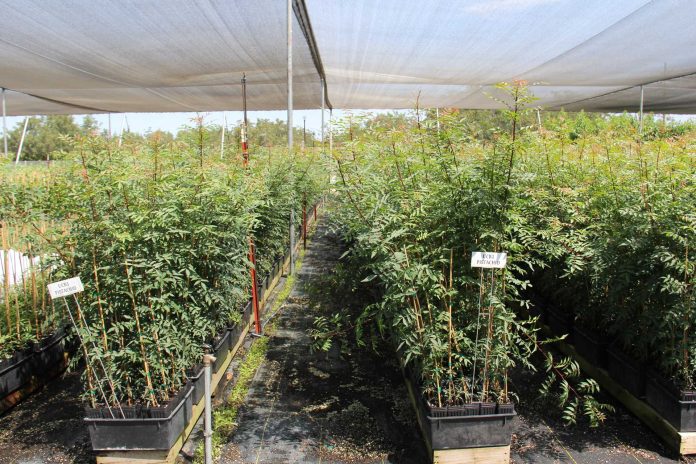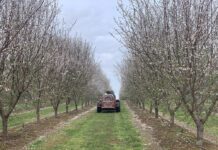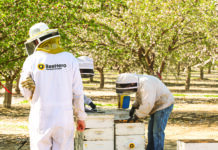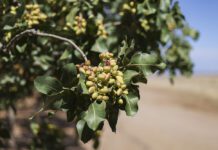A grower’s decision on what variety of tree nut to plant and which rootstock to use is not always easily made. For one thing, a bad decision can be costly and possibly will have to be lived with for years.
What tree nut growers are seeking is a trouble-free tree that will grow well in the soil at the orchard site, be productive and perhaps hit a harvest window desired by the processor. Growers can seek planting advice from a number of sources, but as Agromillora nurseryman Cliff Beumel notes, “There is no guru out there. Don’t rely on one to tell you what to plant.”
There are rootstocks for almonds, pistachios and walnuts that were developed to tolerate certain soil conditions. Rootstocks of trees planted in sandy soils, heavy clay soils and even salty soils need to have the genetic makeup to overcome these conditions. Rootstocks play an important role in how trees tolerate less than optimal soil conditions and support productive tree nut varieties.
Soil is a key factor in choosing a rootstock and variety combination, Beumel said, but it is not the only one.
He said growers may desire to plant a certain variety to hit a desired harvest window. The soil at the orchard site may not be a perfect match for the rootstock or the variety grafted on, but the grower is willing to take the risk because their concerns with harvest outweigh the risk of underperforming trees due to soil conditions.
While stressing there is no one perfect answer or person who can tell you the perfect planting option, Beumel said there are plenty of people who can present growers with the information they can use to make a decision.
“Go to different stakeholders and ask them for relevant information on varieties and rootstocks. It is never an easy decision, but it should be an informed decision.”
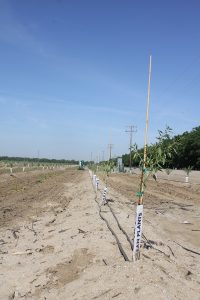
Stakeholder Network
This network of stakeholders can include CCAs, UCCE farm advisors, processors, industry leaders and other trusted growers. It can also include the nursery where the trees are purchased, but Beumel is quick to say while nurseries make the plants, nursery operators are not there for planting advice. They can provide trial data on varieties and rootstocks, he said, but are not licensed to give planting advice.
There are physical properties and environmental conditions at an orchard site that should be given consideration when making planting decisions. Tom Burchell of Burchell Nursery in Oakdale, Calif. said soil type, topography, water source as well as adjacent property crops should all be included in the evaluation process. While production of a certain variety may be the growers’ goal, choosing the right rootstock for the site will make the goal easier to achieve.
“We know that peach-almond rootstocks work in lighter, sandy soils and as a general rule, the more complex rootstocks with plum work better in heavy soils,” Burchell said.
Other physical properties include nematode species present and their levels in the soil as well as soil diseases present like verticillium. Burchell said if this is a replant situation, and the site has been farmed for successive generations of trees, a change in rootstock is important.
“Never go back with the same. Nutrients in the soil are depleted, and even with added organic matter, a change in rootstock with more vigor will help with orchard health,” Burchell said.
Physical Limitations
Ignoring the physical limitations of the soil will make healthy tree growth and productivity difficult or impossible to achieve. Deep ripping and fumigation are mitigation measures that can help but may not overcome poor choices in rootstocks.
Other physical conditions in the soil that would affect a rootstock decision include soil chemistries (pH, alkalinity and sodicity). A soil sample can also reveal deficiencies or excessive levels of certain minerals. Topography is another consideration, Beumel said. Swales or low areas mean drainage can be affected. Does the site have a history of rainwater percolating through the soil profile or does it run into drainage ditches away from the orchard site, he asked?
John Post, president of Agricultural Advisors Inc. in Live Oak, Calif., suggests doing some digging at the orchard site before making a rootstock or variety choice to determine if soil layers will be barriers to drainage or root growth. The best sites for an orchard have minimal layering or barriers to drainage. Depth of the soil layer can determine if better anchorage in the rootstock is necessary. Depth of the water table is another consideration. Rootstocks that cannot tolerate ‘wet feet’ won’t work.
“Backhoe pits are an inexpensive way to see what is beneath the surface,” he said. Doing a soil survey and looking at the soil profile can give indications of barriers to healthy tree production. It is important to evaluate soil structure and texture to determine a good match for a rootstock.
Beumel noted in other tree nut producing countries like Australia, the practice of digging a backhoe pit every two or three acres and deeply analyzing the soil for all these attributes above is very common, even in very large orchard developments. In California, such careful examination at such an intense level of rigor is much less common in his experience, he added. In Australia, for example, he believes that level of analysis is mandated by law.
When planting almonds or walnuts, Post said the history of the site and the previous crops growth there could influence rootstock choices. Replanting almonds after almonds or walnuts after walnuts means soil evaluation for parasitic nematodes and fungi is necessary. If trees in the previous orchard were unhealthy or dying, it is also good to determine why when evaluating new rootstocks, Post said. Soil fumigation may be necessary before replanting and choosing a tolerant rootstock such as VX211 is necessary.
With almonds, he said there are many more choices in rootstocks with different parentages. The range of genetic differences can help overcome specific issues in the soil. The range of varieties can determine tree size and orchard spacing.
UCCE advisor Franz Niederholzer said he tries not to advise growers on what to plant as there is too much riding on the decision.
“I may tell them what I would do, under certain circumstances, but there is too much riding on such a decision,” Niederholzer said. He suggested growers refer to a beta site that can provide information on rootstocks: fruitsandnuts.ucdavis.edu/rootstocks.



